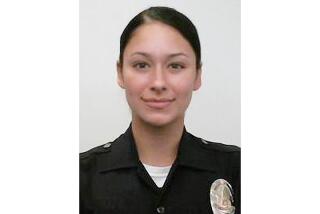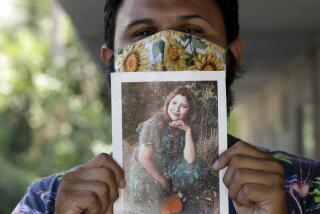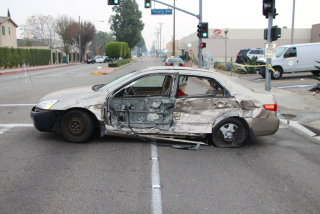Jury sends a message in case involving teen’s cell use
A stunning verdict emerged from a Palmdale courtroom in 2003 that sent a statement about public opinion on cellphone use by drivers, but the case also showed how insurance policies shape the outcome of accident litigation.
The jury was considering the matter of an off-duty Los Angeles police officer injured by a 16-year-old driver of an SUV, who made an illegal U turn.
The teenager was not drunk, under the influence of drugs or otherwise engaged in criminal behavior. The police officer was not permanently crippled, though testimony indicated that he suffered significant pain and that the injuries prevented him from an important promotion.
Although the teenager denied using a cellphone at the time of the accident, her phone records showed that she was on a call at the approximate time of the crash.
“She said she hung up before the accident,” said Hugh J. Grant, the attorney for the young defendant. “The jury didn’t believe her.”
Indeed, the jury delivered a stunning award: $7.3 million for the officer.
Who was going to pay for this and why did the jury give so much? Many cases involving death or permanent disability result in less compensation to victims. Even many drunk driving cases result in lower awards. But this was no ordinary case.
“It was an angry jury,” recalled R. Rex Parris, the Lancaster attorney who represented the police officer.
“It was a very unusual case with some very unusual injury allegations,” Grant said.
What inflamed the jury? Was it the cellphone? The fact that the injured defendant was a police officer? The behavior of the defendant?
The teenager “showed up with a $1,000 Louis Vuitton purse and $1,000 spike heels,” Parris said. “I just wanted the jury to see the purse again. She didn’t want to show it. I asked her if she had the cellphone with her. When she pulled it out, the power was on. She had come to court with a cellphone turned on. The jury was kind of incensed by the whole thing.”
There was other testimony, Parris recalled, that showed the girl’s father, a car dealer in the Antelope Valley, had pressured the police to change the accident report.
Cellphone use has galvanized the auto safety community. In the aftermath of this verdict, the California Assembly considered -- but then failed to approve -- a bill to outlaw hand-held cellphones by drivers. New York, New Jersey and the District of Columbia have outlawed hand-held cellphones.
Despite the controversy and big verdicts, cellphones continue to gain popularity among drivers.
A study by the National Highway Traffic Safety Administration released in February showed that cellphone use by drivers doubled between 2000 and 2004. Surveys of drivers show that 8% of drivers ages 16 to 24 use cellphones at any given time. By comparison, just 1% of drivers age 70 and over use them.
That’s troubling to Parris, who said he believes teenagers’ brains have not developed enough to handle the mental demands of talking and driving. And Grant cautions that using a cellphone carries a clear legal risk.
“It is more and more common in accidents to subpoena production of the driver’s cellphone records,” Grant said. “At all times, drivers are responsible for the safe operation of their vehicles, and when they breach that duty they are liable.”
Nonetheless, the size of the award stunned many attorneys in California, who said it made no sense. But when the dust settled, it did make sense: The two parties agreed to an out-of-court deal that sources close to the case put at $6 million.
Most motorists, of course, carry nowhere near that much coverage. Typically, insurers offer liability of no more than $300,000 per accident, and umbrella policies usually go up to $1 million.
But this case was different. The young driver was covered by her father’s commercial liability policy, which carried a $6 million limit.
In most cases, attorneys say, legal verdicts and accident damages are settled at no more than the defendant’s liability limit.
There are some exceptions, including cases in which a plaintiff can force an insurer to pay more than the policy limit because it had failed to settle within the policy limit when it had a chance.
And drunk drivers who injure others run a greater risk of losing their personal assets, such as homes and retirement savings, Grant said. Such cases are rare, however, according to legal experts.
It can be a mistake to depend on other drivers to carry adequate liability insurance.
“One remedy to the whole problem is to purchase an underinsured policy,” Grant said.
Such policies cover your injuries and costs if another driver is at fault but has minimal coverage. In many respects, underinsured coverage is just as important as uninsured coverage.
Contact Ralph Vartabedian
More to Read
Sign up for Essential California
The most important California stories and recommendations in your inbox every morning.
You may occasionally receive promotional content from the Los Angeles Times.










